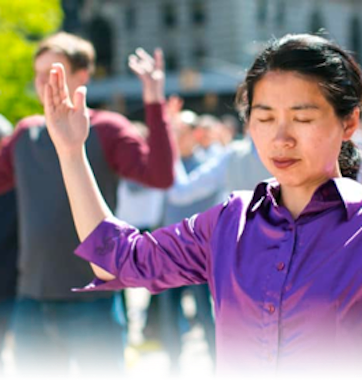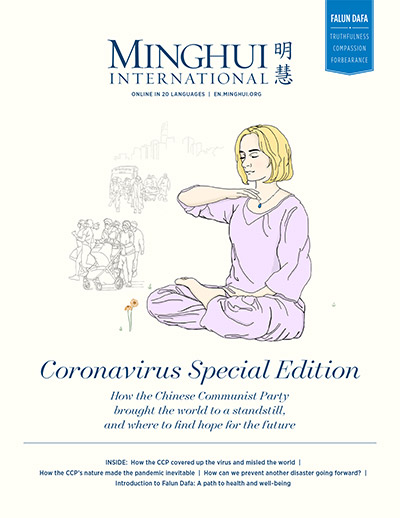(Minghui.org) When I was little, I witnessed how, with few resources, the adults in the village built a bridge over a river. They used stones from a nearby stone mine, sand from near the river, and cement they had to buy.
They first piled up the sand in the shape of an arch where the bridge was to be built, then built the bridge with the stones on top of the sand, and filled the gaps with the cement. The last step was to level the surface. After the cement dried a few days later, they came back and scooped sand out from underneath the stone bridge. That’s how they built a bridge without using any steel or wire. The bridge connected several villages. All kinds of vehicles drive across it every day, but it is still standing and in use after decades.
After it was built, I once looked up from underneath the bridge and saw that the stones butted up against each other randomly. Each one appeared to be suspended in the air, as if it could fall out at any moment. I wondered how that little bit of concrete could hold all those stones together, with none of them ever falling out even with all the traffic running over it.
After I grew up, I realized that the stones relied not only, or not at all, on the concrete to hold them together. The mutual support of the stones of all sizes and shapes gave the bridge the strength to bear weight.
One of the pieces in the Shen Yun performance was the Mongolian chopstick dance. The point of the story was that the strength of a bundle of chopsticks is more than the sum of all its parts. For example, a bundle of ten chopsticks is more than ten times stronger than a single chopstick. The extra strength of the bundle comes from the chopsticks being tightly bound together. By leaning against each another, they create an internal supporting force. The stones that were packed into an arch leaned against and supported one another. As a result, although they appeared to be suspended in the air, they stayed together and could bear weight.
Master said,
“The next person’s things are your things, and your things are his things.” (“Fa Teaching Given at the 2002 Conference in Washington, D.C.,” Collected Teachings Given Around the World Volume II)
As practitioners, we can form an unbreakable entity by supporting one another. This support comes from the altruism Dafa taught us. This is the core value we see in the April 25 incident.
Focus on the Bigger Picture When Defending Practitioners
When it comes to defending practitioners’ rights, we tend to focus only on the practitioner who is being persecuted, rather than putting it into the context of the persecution as a whole.
This keeps us from forming a greater overall force, and can even hurt other practitioners. For example, three practitioners were arrested at the same time for working on the same project. When an officer asked the first two, “Did you make the fliers?” they both answered “No” because it was true, and to defend themselves. In doing so, they had implicated the third practitioner and turned on him.
When someone argued in court that a certain practitioner “did not produce or disseminate the number of fliers the prosecutor accused them of,” one fell into the thinking of protecting the practitioner for that specific case and implicated the practitioner who actually made the fliers. Furthermore, that mindset indirectly acknowledged the legitimacy of the persecution.
In no circumstance should we follow instructions from the evildoers and answer their questions, no matter how simple they are, including questions about our names, education, work, address, or even gender. We should use every opportunity and the time we have to clarify the truth to them, tell them how evil will be punished and kindness rewarded, or even sue them.
Master said,
“No matter what the situation, do not cooperate with the evil’s demands, orders, or what it instigates.” (“Dafa Disciples’ Righteous Thoughts Are Powerful,” The Essentials of Diligent Progress II)
I’ve listed several misconceptions that I’ve observed in which practitioners fell into the trap of defending an individual’s rights at the expense of forming a bigger group and the overall strength of that group.
“Counteracting the Persecution is the Business of the Persecuted, Their Families, and Their Local Practitioners”
When practitioners are persecuted, those who are involved in fighting the persecution or the rescue efforts are often the practitioners themselves, their families, and the practitioners around them.
Most of the practitioners care about the local cases they know and provide the best help they can. The fact is that when persecution takes place, any practitioner can find a legitimate way to file a lawsuit to expose it and raise more awareness. The forms of persecution include but are not limited to illegal sentencing, pension suspension, brainwashing, harassment, or depriving the practitioner of employment opportunities.
When a practitioner is persecuted, he and his family may lack experience, or be distressed. They may not handle the case in the best way possible. Other practitioners can look at the case in a more rational way and file a lawsuit to help the practitioner from a different angle.
Continue Seeking Justice After the Practitioners Are Released
When they were tortured in prisons or brainwashing centers, many practitioners vowed to expose such criminal conduct. But after they were released, besides submitting articles to Minghui and filing lawsuits, few of them took more measures to continue exposing the persecution.
Our efforts to fight the persecution will be more effective if every practitioner who has been incarcerated or tortured exposes the evildoers long after the incidents. We can still file lawsuits to document the details of the brainwashing, forced labor, or imprisonment we suffered even 20 years ago.
Don’t Focus Only On the Results
Win or lose, we should not evaluate our efforts to validate the Fa based on the results of the lawsuits. As long as our minds are righteous as we use the law to fight the persecution, our efforts are bound to be successful. The only party who loses is the evil.
When it comes to getting pensions reinstated and withheld pension payments returned, practitioners have won only a handful of cases nationwide. Nonetheless, in the process, we show people in the social security bureau, the courts, and the Procuratorates that it is illegal to withhold practitioners’ pensions. They will see how the evil incriminates practitioners and persecutes them financially, and they will have another chance to choose a better future. These are all our achievements and progress.
Editor’s note: This article only represents the author’s current understanding in their current cultivation state meant for sharing among practitioners so that we can “Compare with one another in study, in cultivation.” (“Solid Cultivation,” Hong Yin)
All content published on this website is copyrighted by Minghui.org. Non-commercial reproduction must include attribution (e.g. "As reported by Minghui.org, ...") and a link to the original article. For commercial use, contact our editorial department for permission.
Category: Perspective










